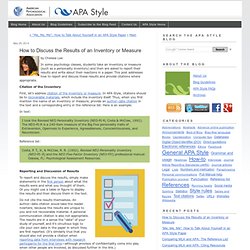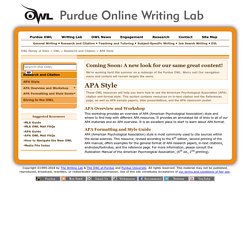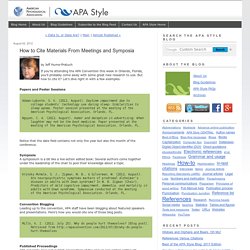

How to Discuss the Results of an Inventory or Measure. By Chelsea Lee In some psychology classes, students take an inventory or measure (such as a personality inventory) and then are asked to report their results and write about their reactions in a paper.

This post addresses how to report and discuss these results and provide citations where appropriate. Citation of the Inventory First, let’s address citation of the inventory or measure. In APA Style, citations should be to recoverable materials, which include the inventory itself. In text: Reference list: Reporting and Discussion of Results To report and discuss the results, simply make statements in the first person about what the results were and what you thought of them. Do not cite the results themselves. Even if you made the results retrievable (e.g., by posting them on a website or including them in an appendix), you still would not cite them, although you can make the reader aware of where to find them (by saying, e.g., “For full results, see the Appendix”). Conclusion. Best of the APA Style Blog: Fall 2012 Edition. APA Style.
Coming Soon: A new look for our same great content!

We're working hard this summer on a redesign of the Purdue OWL. Worry not! Our navigation menu and content will remain largely the same. These OWL resources will help you learn how to use the American Psychological Association (APA) citation and format style. This section contains resources on in-text citation and the References page, as well as APA sample papers, slide presentations, and the APA classroom poster. APA Overview and Workshop This workshop provides an overview of APA (American Psychological Association) style and where to find help with different APA resources. APA Formatting and Style Guide APA (American Psychological Association) style is most commonly used to cite sources within the social sciences. How to Cite Course Packs, Custom Textbooks, and Other Classroom Compendiums. By Jeff Hume-Pratuch If you’ve taken a college course in the last 20 years, you’ve probably used a course pack—a collection of information put together specifically for your class.

Course packs can be as simple as a stapled packet or as fancy as a hardbound book with a four-color cover. They’re usually compiled by the instructor from relevant articles, chapters, and original material; they may be printed by the college print shop, outsourced to a local copy shop, or ordered through a custom textbook manufacturer. It’s increasingly common to provide all or part of the book in electronic form as well. Course packs are seldom cited in journal articles, but students are often given the assignment of writing on a specific extract from the textbook.
Previously Published Articles or Chapters Let’s say you’re working from a course pack for a neuropsychology class, and you need to cite a journal article included in it. Original or Unattributed Material Supplemental Material. How to Cite Materials From Meetings and Symposia. By Jeff Hume-Pratuch If you’re attending the APA Convention this week in Orlando, Florida, you’ll probably come away with some great new research to use.

But how to cite it? Let’s dive right in with a few examples. Papers and Poster Sessions Notice that the date field contains not only the year but also the month of the conference. SymposiaA symposium is a bit like a live-action edited book: Several authors come together under the leadership of the chair to pool their knowledge about a topic. Convention BloggingLeading up to the convention, APA staff have been blogging about featured speakers and presentations. Published ProceedingsAPA generally does not publish proceedings of the annual convention (although selected abstracts are available in the online program). Increasingly, proceedings are being made available on CD to reduce publishing costs.